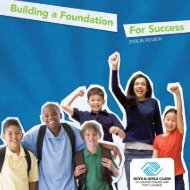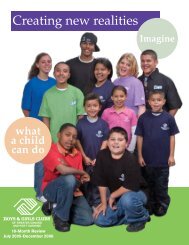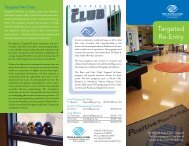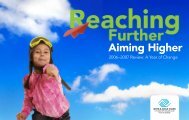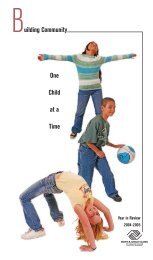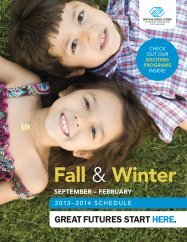PrimaveraâVerano - Boys and Girls Clubs of Greater Oxnard and ...
PrimaveraâVerano - Boys and Girls Clubs of Greater Oxnard and ...
PrimaveraâVerano - Boys and Girls Clubs of Greater Oxnard and ...
- No tags were found...
You also want an ePaper? Increase the reach of your titles
YUMPU automatically turns print PDFs into web optimized ePapers that Google loves.
40 Developmental Assets TMSearch Institute SM has identified the following building blocks <strong>of</strong> healthydevelopment that help young people grow up healthy, caring, <strong>and</strong> responsible.CategoryAsset Name <strong>and</strong> DefinitionExternal AssetsSupportEmpowermentBoundaries &ExpectationsConstructiveUse <strong>of</strong> Time1. Family Support-Family life provides high levels <strong>of</strong> love <strong>and</strong> support.2. Positive Family Communication-Young person <strong>and</strong> her or his parent(s) communicate positively,<strong>and</strong> young person is willing to seek advice <strong>and</strong> counsel from parents.3. Other Adult Relationships-Young person receives support from three or more nonparent adults.4. Caring Neighborhood-Young person experiences caring neighbors.5. Caring School Climate-School provides a caring, encouraging environment.6. Parent Involvement in Schooling-Parent(s) are actively involved in helping young person succeedin school.7. Community Values Youth-Young person perceives that adults in the community value youth.8. Youth as Resources-Young people are given useful roles in the community.9. Service to Others-Young person serves in the community one hour or more per week.10. Safety-Young person feels safe at home, school, <strong>and</strong> in the neighborhood.11. Family Boundaries-Family has clear rules <strong>and</strong> consequences <strong>and</strong> monitors the young person’swhereabouts.12. School Boundaries-School provides clear rules <strong>and</strong> consequences.13. Neighborhood Boundaries-Neighbors take responsibility for monitoring young people’s behavior.14. Adult Role Models-Parent(s) <strong>and</strong> other adults model positive, responsible behavior.15. Positive Peer Influence-Young person’s best friends model responsible behavior.16. High Expectations-Both parent(s) <strong>and</strong> teachers encourage the young person to do well.17. Creative Activities-Young person spends three or more hours per week in lessons or practice inmusic, theater, or other arts.18. Youth Programs-Young person spends three or more hours per week in sports, clubs, ororganizations at school <strong>and</strong>/or in the community.19. Religious Community-Young person spends one or more hours per week in activities in a religiousinstitution.20. Time at Home-Young person is out with friends "with nothing special to do" two or fewer nightsper week.Internal AssetsCommitmentto LearningPositiveValuesSocialCompetenciesPositiveIdentity21. Achievement Motivation-Young person is motivated to do well in school.22. School Engagement-Young person is actively engaged in learning.23. Homework-Young person reports doing at least one hour <strong>of</strong> homework every school day.24. Bonding to School-Young person cares about her or his school.25. Reading for Pleasure-Young person reads for pleasure three or more hours per week.26. Caring-Young person places high value on helping other people.27. Equality <strong>and</strong> Social Justice-Young person places high value on promoting equality <strong>and</strong> reducinghunger <strong>and</strong> poverty.28. Integrity-Young person acts on convictions <strong>and</strong> st<strong>and</strong>s up for her or his beliefs.29. Honesty-Young person "tells the truth even when it is not easy."30. Responsibility-Young person accepts <strong>and</strong> takes personal responsibility.31. Restraint-Young person believes it is important not to be sexually active or to use alcohol or otherdrugs.32. Planning <strong>and</strong> Decision Making-Young person knows how to plan ahead <strong>and</strong> make choices.33. Interpersonal Competence-Young person has empathy, sensitivity, <strong>and</strong> friendship skills.34. Cultural Competence-Young person has knowledge <strong>of</strong> <strong>and</strong> comfort with people <strong>of</strong> differentcultural/racial/ethnic backgrounds.35. Resistance Skills-Young person can resist negative peer pressure <strong>and</strong> dangerous situations.36. Peaceful Conflict Resolution-Young person seeks to resolve conflict nonviolently.37. Personal Power-Young person feels he or she has control over "things that happen to me."38. Self-Esteem-Young person reports having a high self-esteem.39. Sense <strong>of</strong> Purpose-Young person reports that "my life has a purpose."40. Positive View <strong>of</strong> Personal Future-Young person is optimistic about her or his personal future.This page may be reproduced for educational, noncommercial uses only.Copyright © 2004 by Search Institute SM , 615 First Ave NE Suite 125, Minneapolis, MN 55413; 800-888-7828; www.search-institute.org.The following are trademarks <strong>of</strong> Search Institute: Search Institute SM , Developmental Assets TM , <strong>and</strong> Healthy Communities•Healthy Youth®.16 | BOYS & GIRLS CLUBS OF GREATER OXNARD AND PORT HUENEME 1900 Primavera–Verano W. Fifth Street, 2010 <strong>Oxnard</strong>, CA 93030



